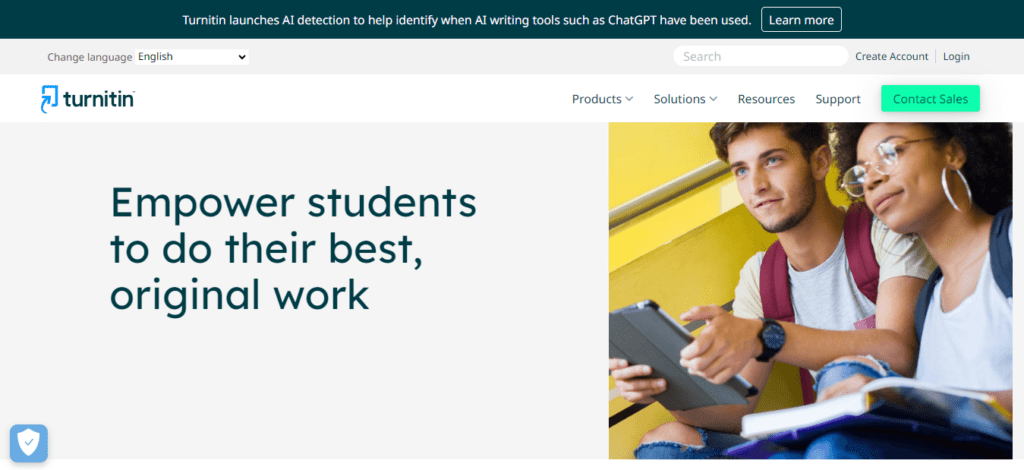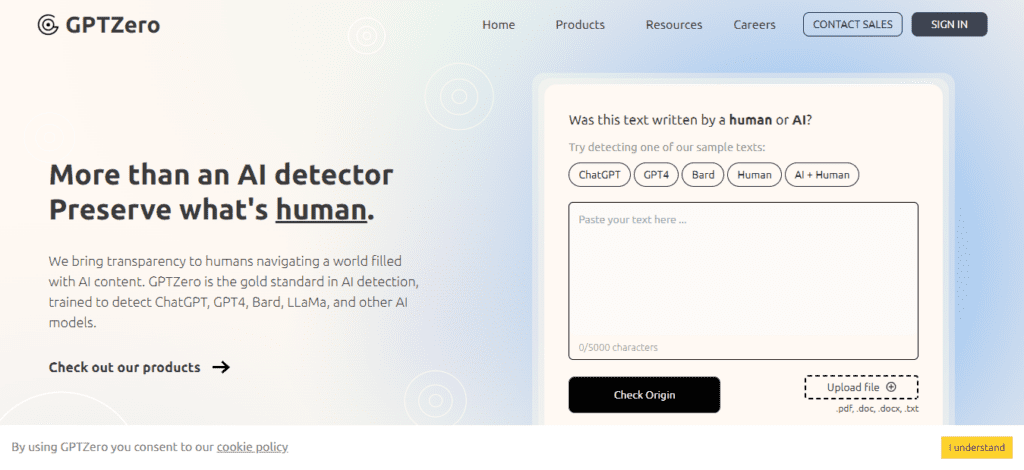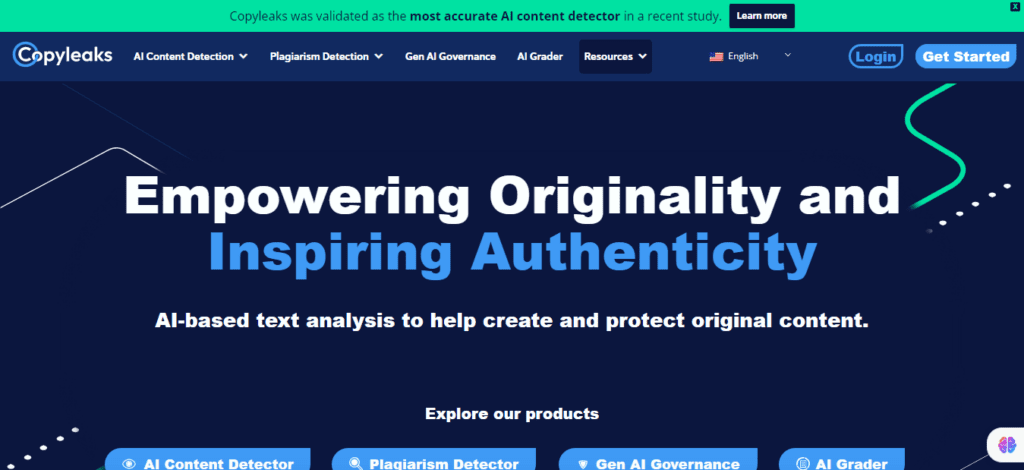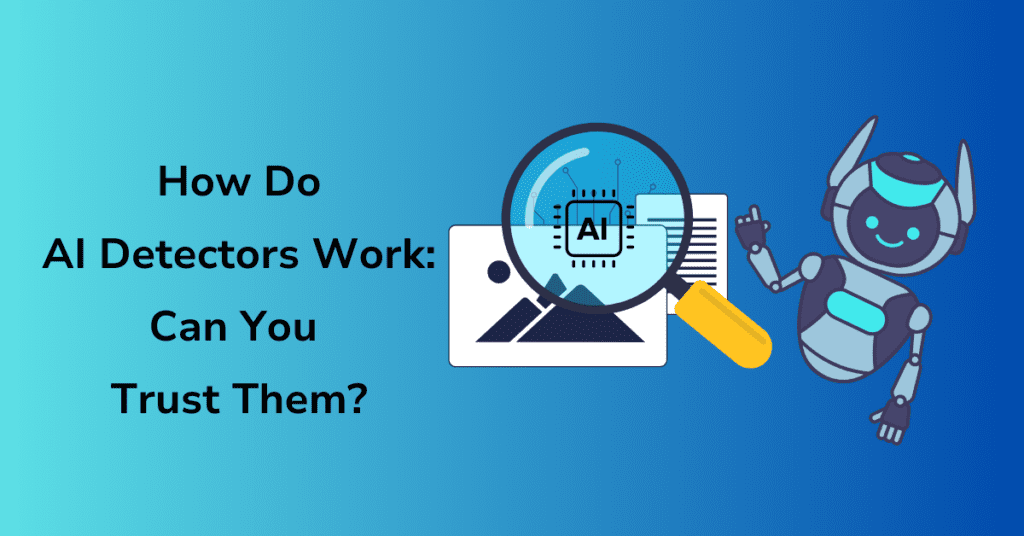Artificial Intelligence has been the talk of the town for quite some time. However, the relevancy and popularity of these platforms have increased significantly after the launch of ChatGPT and GPT-4 (a unique chatbot).
From AI-generated text to developing codes and creating AI images, Chat GPT can do wonders for individuals and businesses these days.
There is no denying that AI technology is fantastic in many capacities, but using AI-generated content could be a fundamental matter of concern for students when they use AI text for plagiarism rather than research.
Indeed, human-written content is irreplaceable, but students prefer free AI tools like ChatGPT these days to complete their assignments and research work.
That’s why identifying content written by a human has become daunting for teachers and professors, as they can’t determine if students have used their knowledge and research skills to write an assignment or if they are using AI-generated content.
But every problem has a probable solution, and detecting AI-generated text is no exception.
The availability of AI detectors has made it possible to detect AI content quickly. These AI checkers can bypass AI text and identify whether it’s human-written text or content written by AI.
Let’s discuss more about the significance of AI detectors in this era of AI technology.
What Is AI Detection?
The need for ChatGPT detectors or AI content detectors is increasing drastically as more AI text-generated tools are coming out these days. These AI detectors help identify whether a piece of text is human-written content or text generated by AI.
Machine learning and natural language models work with the AI checker to detect AI-generated content. Most of these AI detectors won’t say if text is AI-generated. They highlight the percentage of AI generated content vs text written by humans. AI detectors are primarily based on language models similar to those used in the AI-writing tools they aim to detect.
AI detection tools use predictable patterns with sentence structure and wordings to identify AI-generated content. These tools have specific coding and training data to detect patterns as they don’t understand the context and meaning of the words.
Sometimes, these detectors can provide false positives for AI writing due to the limited knowledge base compared to humans. They also detect ChatGPT plagiarism, another significant sign of AI-written text.
AI Content Detectors: How Do They Work?
How do content detectors work?
They use a substantial database of AI content creation and human-written content to determine patterns within their writing. Their datasets enable them to discover the practices associated with AI or human writing to decide the likelihood of AI-written content or human-generated content.
Unquestionably, AI content detectors have advanced machine learning algorithms but are imperfect, and you can only rely on them partially. You can use them to identify AI content probability scores. Still, it is always preferable to thoroughly read the content to explore the plagiarized or AI content not detected by software.
These tools show the finest results using natural language processing. But you can’t deny that they are computer programs and not accurate like humans.
Surprisingly, the best AI language models can make mistakes when the provided piece of content is full of typos and grammar errors.
If your content reads like it was AI generated, it may affect how search engines rank it.
Using plagiarism-checkers and advanced AI detectors is recommended if you want to check the exact percentage of copied text or AI generated content.
Therefore, it’s tricky to decide whether to trust AI content detectors or not. Even the best AI language models fail to identify where the content is flagged. So, it’s preferable to use your skills, expertise, and AI detection software to analyze your text to determine the AI content percentage.
The 4. Techniques To Identify AI Generated Text
Undeniably, AI-written text is getting more sophisticated, and you can’t easily distinguish between AI vs human written text. These AI or Chat GPT detectors use machine-learning advanced algorithms and Natural Language Processing (NLP) techniques to identify common features and patterns in AI-created content.
Whether you are using free AI detectors or premium ones, here’s how they work.
Classifiers
A classifier is trained to identify text generated by an AI or a particular model. Besides, it determines the language patterns of the text.
Embeddings
Embeddings turn data into a format where similar items are grouped close together. This method helps models recognize and understand text.
Perplexity
Perplexity measures “uncertainty” or “surprise” elements across the new text. It is also known as “complexity” or “randomness of the text”.
Burstiness
Comparing multiple variations of the sentences is known as Burstiness (such as det, different words, etc.), with algorithms to determine when a burst occurs in a sentence or a phrase.
Use Cases For AI Content Detection
People rely more on AI models to create content to save time. That’s why avoiding the importance of AI detection tools to create unique text and recognize AI text for SEO and blog posts has become inevitable.
Everyone needs AI content detection software to create unique and plagiarized-free content, from students to content writers and business persons.
Students: Students can use these tools before submitting their final projects to enhance their source credibility and grades.
Educators: Educators can use the tool to find if their students’ written content is unique or not.
Publishers: They can use AI content detection tools to confirm they publish unique and legitimate content.
Content Managers/Creators: AI generated or plagiarized content can affect the SEO ranking of the content on search engines. That’s why it is recommended and preferable for them to use such magical tools to detect human vs AI content before publishing their work.
SEO Managers: SEO managers can also use these tools to identify fake news or AI-generated text, as it can affect their website ranking on search engines.
Social Media Marketers: Posting fake news or plagiarized content on social media is quite risky. To avoid this, it’s better to use AI detectors.
Top 5 AI Detectors to Identify AI-Generated Text
Indeed, there is no perfect tool to detect AI content, but some tools are better than others.
Here are our top 5 picks for you.
1- Turnitin
Turnitin is a leading name when it comes to AI content detectors. Known for its accuracy and efficiency, the software sets the bar high in detecting plagiarized or duplicate content. Whether you are a student, educator, or professional, Turnitin offers solutions that ensure the originality and quality of written work.
- Comprehensive Database: It scans through billions of web pages, academic journals, and publications to ensure the content’s uniqueness.
- Speed and Efficiency: It delivers fast yet thorough results, helping you meet deadlines without compromising quality.
- Multi-Layer Checks: Turnitin doesn’t just check for word-to-word copying; it can also detect paraphrasing, which needs to be noticed.
- Integration: It seamlessly integrates with multiple platforms, making it user-friendly.
- Educational Insights: Unlike GPT-3, which is designed for multiple tasks, it specializes in educational needs, providing in-depth feedback that aids learning.
In a world where the line between original and copied content can get blurred, Turnitin serves as the Bard of originality, ensuring that each written piece stands out as unique.


2- GPTZero
Built on cutting-edge technology similar to GPT4, GPTZero offers many features that make it a leader in the field.
Features
- High Accuracy: Utilizes advanced algorithms for precise content detection.
- Speed: Offers real-time analysis, making it efficient and quick.
- User-Friendly: Designed with an intuitive interface for ease of use.
- Versatility: Capable of handling different types of content, making it suitable for various applications.
- Built on GPT 4: Incorporates some of the most advanced machine learning techniques.
These attributes collectively contribute to making GPTZero a standout tool for content detection.


3- Copyleaks
Copyleaks is not just a simple software to highlight copied content; it’s a robust solution that uses advanced algorithms to provide a comprehensive content scan.
- Highly Accurate: The software uses a sophisticated detection model that minimizes false positives.
- Bypass AI Detection: Unlike many other tools, it can identify manipulated text that tries to bypass AI detection methods.
- Multiple File Formats: It supports various file types, making it versatile for different needs.
- API Access: For those looking to integrate it into their systems, API access is available.
- Multilingual Support: It can scan content in multiple languages, a feature not found in many other tools.
The variety of features and exceptional accuracy make Copyleaks an unparalleled choice for detecting copied or manipulated content.


4- Originality.ai
Originality.ai stands out as the best AI content detector for several compelling reasons.
- Advanced Algorithms: Originality.ai utilizes cutting-edge algorithms trained by OpenAI, ensuring high accuracy in detecting content originality.
- Semantic Analysis: This feature allows the tool to understand the context of the text, making its detection capabilities far more nuanced than simple keyword-based approaches.
- User-Friendly Interface: The platform is designed to be easy to navigate, making it accessible for all skill levels.
- Speed: The tool quickly scans and analyzes large volumes of text, saving users valuable time.
- Customizability: Users can tailor the settings to fit their needs, providing a personalized experience.
These features make Originality.ai a highly effective and reliable choice for content detection.


5- Quetext
Quetext sets the bar high for text analysis and plagiarized content detection, making your content less likely to be flagged unfairly.
- DeepSearch Technology: Quetext uses this unique tech to scan deeply through documents for plagiarism.
- Contextual Analysis: It doesn’t just look for identical matches; it understands the context.
- Citation Assistant: Helps you properly credit sources, reducing the risk of accidentally plagiarized content.
- Large Language Support: Quetext understands and analyzes multiple languages, not just English.
- Confidentiality: Your documents are safe and secure not stored in any database.
These features and its semantic analysis capabilities make Quetext an unparalleled choice for detecting content originality.


Is Google Detecting ChatGPT?
Spam and plagiarized content can affect your ranking on search engines, including Google.
But what about the content generated by ChatGPT or a platform like CopyScribe AI?
Currently, there’s no evidence to suggest that Google is actively looking to find and identify content made by AI. Google has also confirmed that they don’t have a problem with AI-generated content.
The Future of AI Writing & Content Detection
Looking ahead, the future of AI writing and content detection is promising. As technology advances, these tools are getting better at understanding context and nuance, making them more reliable for various applications.
One challenge to overcome is reducing “false negatives,” where legitimate content is mistakenly flagged as suspicious. However, as semantic analysis and machine learning algorithms become more sophisticated, we can expect fewer errors and more accuracy.
These improvements will make AI-writing tools faster and more dependable for tasks like content creation, plagiarism checking, and data security.
Frequently Asked Questions
Do AI detectors work on Quillbot?
Yes, many AI detectors can analyze content generated by Quillbot to check for things like plagiarism or content originality.
Which AI detection does Turnitin use?
Turnitin employs proprietary protocols for its detection mechanism. It scans academic databases, writing tools, the internet, and many student papers to identify potential plagiarism.
What AI detectors do universities use?
Universities commonly use software like Turnitin, Copyscape, or Plagscan to detect plagiarism and ensure content originality. Some might also use custom-built solutions based on advanced procedures.
Is the Turnitin AI detector accurate, according to Reddit?
Opinions on Reddit vary, but many users consider Turnitin highly accurate in detecting copied content. It is often seen as a reliable tool for academic settings.
Can AI detectors detect paraphrasing?
Yes, advanced AI detectors can detect paraphrasing by using semantic analysis to understand the meaning of the text rather than just matching exact words. This allows them to identify content that has been rewritten but still lacks originality.


